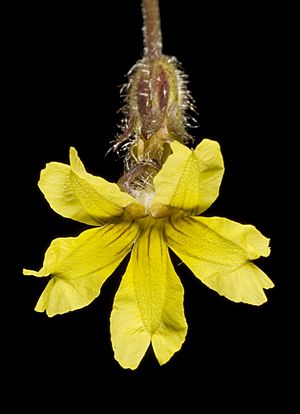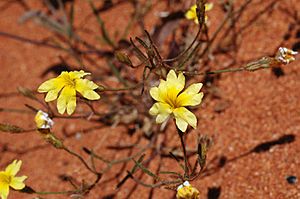Goodenia berardiana facts for kids
Quick facts for kids Goodenia berardiana |
|
|---|---|
 |
|
| Scientific classification | |
| Genus: |
Goodenia
|
| Species: |
berardiana
|
| Synonyms | |
|
List
|
|

Goodenia berardiana is a type of flowering plant. It belongs to the Goodeniaceae family. This plant is special because it only grows in Australia. It is an annual herb. This means it lives for just one growing season. It grows upright and can be found in many places. Its leaves can be long and thin, or shaped like an egg. Sometimes they have small teeth or lobes. The flowers are yellow and grow in groups. They can be in long clusters called racemes. Or they can be in umbrella-shaped groups called umbels.
What Does It Look Like?
Goodenia berardiana is an upright plant. It usually grows up to 40 centimeters (about 16 inches) tall. Its leaves are 20 to 160 millimeters (about 0.8 to 6.3 inches) long. They are also 2 to 12 millimeters (about 0.08 to 0.5 inches) wide. The leaves can be long and narrow. They can also be egg-shaped, with the narrow end at the bottom. Sometimes, the edges of the leaves have small teeth or lobes.
The flowers grow in clusters. These clusters can be long racemes. Or they can be smaller, umbrella-shaped umbels. Each flower has small, leaf-like parts called bracts at its base. Each flower also sits on a short stalk called a pedicel. This stalk is usually 2 to 7 millimeters long.
The plant has narrow, oval-shaped sepals. These are small, leaf-like parts that protect the flower bud. They are about 1.5 to 2.5 millimeters long. The petals are yellow and are 6 to 15 millimeters long. They feel hairy on the inside. The lower parts of the flower's petals are 2.5 to 7 millimeters long. They have small "wings" that are about 1 to 2.5 millimeters wide.
This plant mainly flowers from May to October. After flowering, it produces a fruit. This fruit is an oval-shaped capsule. It is about 8 to 12 millimeters long.
How It Got Its Name
This plant was first officially described in 1829. A French botanist named Charles Gaudichaud-Beaupré described it. He called it Distylis berardiana in his book. This book was about his voyage around the world.
Later, in 1979, Roger Charles Carolin changed its name. He renamed it Goodenia berardiana. This new name was published in a science journal called Brunonia. The second part of the name, berardiana, honors Auguste Bérard. He was a young officer on the ship during Freycinet's voyage.
Where Does It Grow?
Goodenia berardiana can be found in many different places. It often grows in sandy, stony, or gravelly soils. You might also find it on plains where mulga trees grow.
This plant grows in the drier parts of Australia. You can find it in southern and western Western Australia. It also grows in South Australia, the southern Northern Territory, and the far west of New South Wales.

